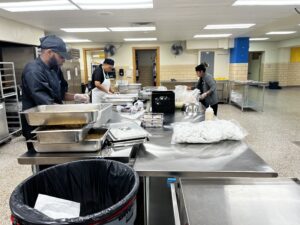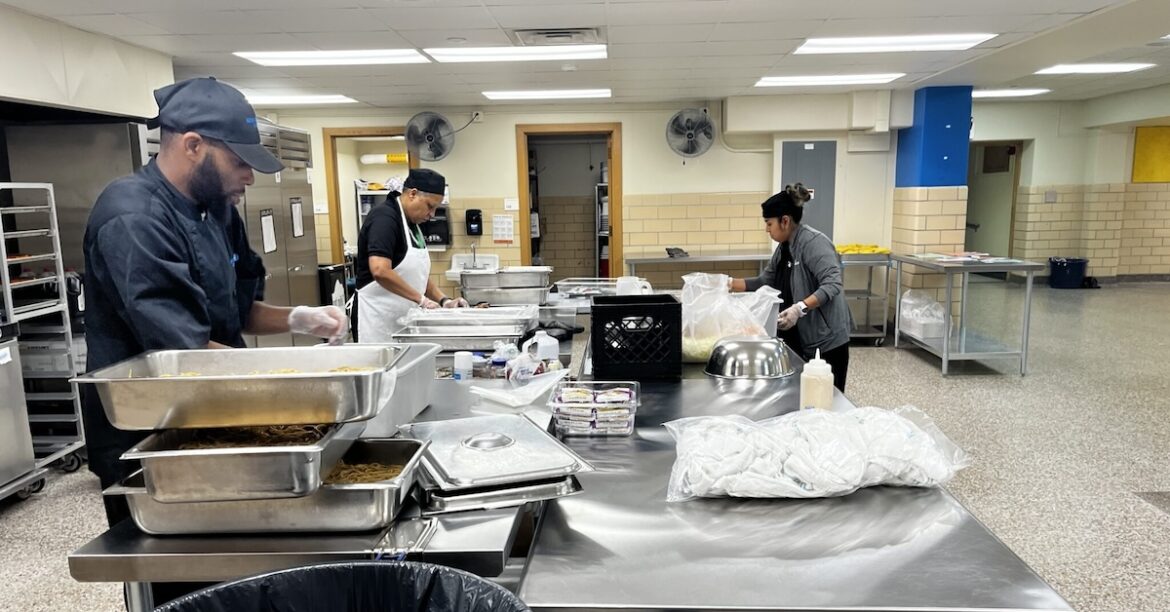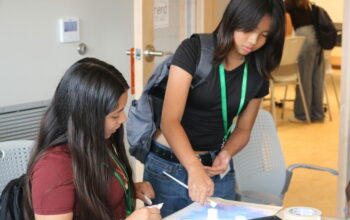On a Tuesday morning in a stainless-steel kitchen on Madison’s East Side, two women are plating just-out-of-the-oven honey ginger chicken and tofu, preparing noodles for lo mein and chopping fresh vegetables from local producers.
This is not the neighborhood’s hot new restaurant, but Nuestro Mundo Community School, a bilingual elementary charter school in the Madison Metropolitan School District. Since February, Nuestro Mundo students have enjoyed lunches cooked from scratch on Tuesdays and Thursdays as part of a pilot initiative which the creators hope will be coming to more Madison schools soon.
“The goal is to create a blueprint so we can get other schools started,” said Tyrone Reese, Nuestro Mundo’s culinary development and production manager. Before coming to the district, Reese ran the food program at the Goodman Community Center. He’d heard stories about the state of Madison school lunches, including the time in 2022 when students were fed pizza for nine days straight.
When he was hired at Nuestro Mundo in October 2022, Reese “had the same vision” as Josh Perkins, the district’s director of food services, who’s been determined to improve the quality and reputation of Madison school lunches since he was brought on in March 2022. Speaking to WMTV in February about the pilot program, Perkins said, “this is the kind of food we should be putting in front of students in Madison.”
The fight for better school lunches
The scratch cooking pilot program is the latest step in an ongoing effort to provide healthier, more diverse options in Madison school lunches.
Over the last several years, the Madison Metropolitan School District’s food program has been criticized for serving unhealthy options — like sugary Craisins standing in as a “fresh fruit or veggie” — and dysfunctional menu apps.
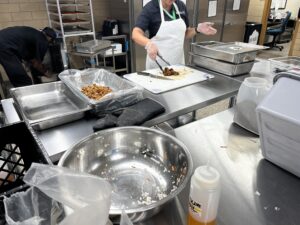
The district’s chief of operations Cedric Hodo attested in 2022 that the district was meeting the USDA’s minimum nutritional requirements for school lunches. And district officials previously cited a combination of staffing shortages and pandemic-related supply chain issues as causes for the shortcomings.
Last year, MMSD launched several research projects to better understand factors influencing parents' and children’s decisions to purchase school lunch and answer questions like how to reduce food waste. Perkins is also hoping to expand the district’s offerings to include foods that are more culturally diverse.
A growing trend
Though new to Madison schools, the scratch cooking program is far from the first of its kind. The program was made possible thanks to the Chef Ann Foundation, a nonprofit that has supported scratch cooking in schools around the country for the last 13 years. Perkins was recently awarded the foundation’s Healthy School Food Pathway Fellowship.
Earlier this year, Roseville Area High School outside Minneapolis started its own scratch cooking program. “We actually took a trip out to Minnesota and learned more about what it took to go down the scratch cooking route,” Reese said.
Nuestro Mundo was chosen to pilot the scratch cooking program owing to the school’s history with smaller-scale scratch cooking experiments, and the fact that the school’s new building — which it moved into last year — features upgraded kitchen equipment better suited to cooking on-site.
The future of scratch cooking in Madison schools
Since February, when the program began, the scratch cooking menu has only been offered during Nuestro Mundo’s three lunch services on Tuesdays and Thursdays. Right now, Reese and the team of food service workers at Nuestro Mundo are “just getting familiar with the set-up of scratch cooking,” Reese said, as opposed to “essentially reheating food,” which was “what we did before.”
The ultimate goal is to offer scratch menus five days a week at Nuestro Mundo and expand the program to more Madison schools.
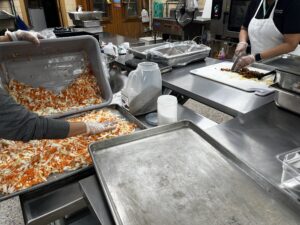
"We’re trying to make the spring (semester) kind of the incubator, and then exactly how far and how fast it goes from there is an open question," Perkins told the Wisconsin State Journal. Reese said he is “figuring out all the pros and cons, making sure we’re adjusting things as needed,” so the district can “copy and paste” the model onto other schools throughout the city.
Most of the ingredients for the scratch food program come from the district’s regular food distributor, Iowa-based Martin Bros., with some vegetables coming from local producers.
Currently, Reese said, the biggest hurdles to expansion are training and equipment. Nuestro Mundo’s kitchen was renovated specifically to meet the demands of the scratch cooking program. And Reese is personally training the school’s food service workers.
Making a positive impact
Back in the Nuestro Mundo kitchen, two of the school’s food service workers, Ana Paula Johnson-Strader and Agustina Perez Gomez, are hard at work preparing the day’s lunches. Reese also arrives early on scratch cooking days to assist with food preparation and help train staff.
Even though the scratch menu is currently only offered two days a week, the program’s positive impact is already evident. “Kids who used to bring home lunches,” Reese said, “at least on Tuesdays and Thursdays, they’re eating in the cafeteria.”
Since the start of the pilot program, the school has seen a consistent increase in the number of school lunches purchased on Tuesdays and Thursdays. “Sometimes we have picky kids who don’t like to eat anything,” Johnson-Strader said, “but they see other kids eating next to them, and they try it and they like it.”
The biggest hit? “[Honey ginger] tofu, believe it or not,” Johnson-Strader said. Other scratch menus include chicken and cilantro lime rice with roasted broccoli. Johnson-Strader says students across the board “are eating more of everything and they’re getting more vegetables.”
“I was terrified at the beginning,” Johnson-Strader said, as Reese demonstrated in what size he wanted the pieces of honey ginger chicken to be cut. But, she adds, “the kids are loving it, so it’s worth it.”
